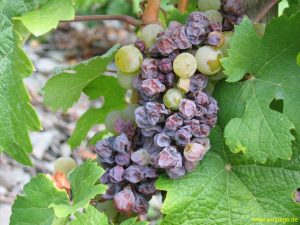Learning about wine
Botrytis Cinerea, the first step in obtaining wines from noble molds

Thanks to a group of researchers from the University of Davis headed by Dr. Dario Cantu has been shown how the activity of Botrytis Cinerea can change the plant’s metabolism by producing new flavors and aromas. The study was carried out at the Dolce Winery in California’s Napa Valley. Funding was provided by the UC Davis College of Agricultural and Environmental Sciences while the supporting instrumentation was provided by Agilent Technologies.
The Botrytis Cinerea
Botrytis Cinerea, commonly known as “noble rot”, is a type of fungus that attacks the skin of the berries and is the cause of the undesirable gray rot of the bunch. It is a destructive disease that inflicts severe crop losses all over the world. In particular conditions, this organism can however also develop only within the berries, causing profound changes in the chemical composition of the future must: in this form it plays a decisive role in the production of some of the largest and most renowned dessert wines in the world.
Wines from noble molds
The production of muffato wines began in the sixteenth century, especially in the regions of Tokaj in Hungary, Rheingau in Germany and Sauternes in France, extending then even more recently also in Italy and other countries. These natural sweet wines have distinctive profiles of aroma and fruity and honeyed flavor.
The discovery
Davis’ team discovered that noble mold induces some metabolic processes in white grape berries that normally occur when red grapes ripen. The research has also confirmed another thing: the reprogramming of the metabolism of grapes affected by Botrytis causes a substantial accumulation of aromas and flavors, which are precisely the key elements of the great complexity of sweet wines produced from botrytized grapes. Through transcriptomic and metabolomic analysis, together with enzymatic assays, it was possible to demonstrate that noble mold alters the metabolism of sémillon grapes inducing the production of metabolites involved in the generation of aromas and flavors and triggers the metabolic regulators that are typically associated to the maturation process of red berried grapes.
Furthermore, the work may lead to new approaches not only to improving the quality characteristics of grapes, but also of other fruits.
Are you also great lovers of fruity wines? Try them here!
Good day! Ilde





